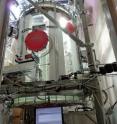Pine forest particles appear out of thin air, influence climate
Pine forests are especially magical places for atmospheric chemists. Coniferous trees give off pine-scented vapors that form particles, very quickly and seemingly out of nowhere. New research by German, Finnish and U.S. scientists elucidates the process by which gas wafting from coniferous trees creates particles that can reflect sunlight or promote cloud formation, both important climate feedbacks. The study is published Feb. 27 in Nature.
"In many forested regions, you can go and observe particles apparently form from thin air. They're not emitted from anything, they just appear," said Joel Thornton, a University of Washington associate professor of atmospheric sciences and second author on the paper.
The study shows the chemistry behind these particles' formation, and estimates they may be the dominant source of aerosols over boreal forests. The Intergovernmental Panel on Climate Change has named aerosols generally one of the biggest unknowns for climate change.
Scientists have known for decades that gases from pine trees can form particles that grow from just 1 nanometer in size to 100 nanometers in about a day. These airborne solid or liquid particles can reflect sunlight, and at 100 nanometers they are large enough to condense water vapor and prompt cloud formation.
In the new paper, researchers took measurements in Finnish pine forests and then simulated the same particle formation in an air chamber at Germany's Jülich Research Centre. A new type of chemical mass spectrometry let researchers pick out 1 in a trillion molecules and follow their evolution.
Results showed that when a pine-scented molecule combines with ozone in the surrounding air, some of the resulting free radicals grab oxygen with unprecedented speed.
"The radical is so desperate to become a regular molecule again that it reacts with itself. The new oxygen breaks off a hydrogen from a neighboring carbon to keep for itself, and then more oxygen comes in to where the hydrogen was broken off," Thornton said.
Current chemistry would predict that 3 to 5 oxygen molecules could be added per day during oxidation, Thornton said. But researchers observed the free radical adding 10 to 12 oxygen molecules in a single step. This new, bigger molecule wants to be in a solid or liquid state, rather than gas, and condenses onto small particles of just 3 nanometers. Researchers found so many of these molecules are produced that they can clump together and grow to a size big enough to influence climate.
"I think unravelling that chemistry is going to have some profound impacts on how we describe atmospheric chemistry generally," Thornton said.
Lead author Mikael Ehn did the work as a postdoctoral researcher in Germany, working in the group of co-author Thomas Mentel. Ehn is now based at the University of Helsinki in Finland.
Boreal or pine forests give off the largest amount of these compounds, so the finding is especially relevant for the northern parts of North America, Europe and Russia. Other types of forests emit similar vapors, Thornton said, and he believes the rapid oxidation may apply to a broad range of atmospheric compounds.
"I think a lot of missing puzzle pieces in atmospheric chemistry will start to fall into place once we incorporate this understanding," Thornton said.
Forests are thought to emit exponentially more of these scented compounds as temperatures rise. Understanding how those vapors react could help to predict how forested regions will respond to global warming, and what role they will play in the planet's response.
In related work, Thornton's group was part of a campaign last summer to study air chemistry over the Southeastern United States, where aerosols formed by reforested areas or from pollution could help explain why that region has not warmed as much as other places.
"It's thought that as the Earth warms there will be more of these vapors emitted, and some fraction of them will be converted to particles which can potentially shade the Earth's surface," Thornton said. "How effective that is at temperature regulation is still very much an open question."
The 33 co-authors also include Felipe Lopez-Hilfiker and Ben Lee, both at the UW, and researchers from the University of Copenhagen in Denmark, the Institute for Tropospheric Research in Germany, Aerodyne Research Inc. in Massachusetts, and Tampere University of Technology in Finland.
The research was funded by the European Research Council, Academy of Finland Center of Excellence, U.S. Department of Energy, and the Emil Aaltonen Foundation.
Source: University of Washington
Other sources
- Pine forest smell helps keep planet coolfrom Science BlogThu, 27 Feb 2014, 14:30:45 UTC
- Pine forest particles appear seemingly out of thin air, influence climatefrom Science DailyThu, 27 Feb 2014, 14:02:14 UTC
- Pine smell 'limits' climate changefrom BBC News: Science & NatureWed, 26 Feb 2014, 20:50:47 UTC
- Pine forest particles appear out of thin air, influence climatefrom PhysorgWed, 26 Feb 2014, 19:52:58 UTC

